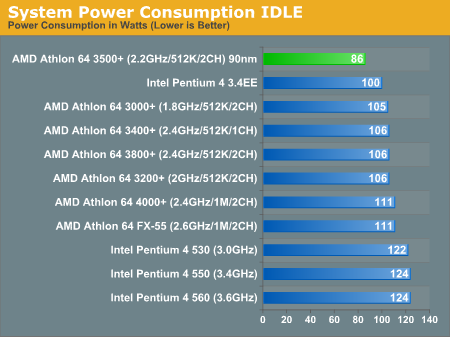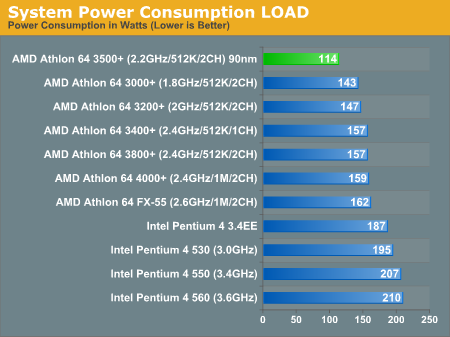AMD Athlon 64 4000+ & FX-55: A Thorough Investigation
by Anand Lal Shimpi on October 19, 2004 1:04 AM EST- Posted in
- CPUs
Power Consumption
To measure power consumption we looked at overall system power consumption and tried to keep as many variables static. There are some basic differences which we cannot get around, mainly that the 925X uses lower voltage DDR-II while the nForce4 uses regular DDR, but for the most part our results were quite controlled. We also included power consumption figures from 130nm Socket-939 Athlon 64 3200+ and 3000+ chips, which as you may know, do not exist. The reason we did this was to show the sharp contrast to the power consumption figures of the 90nm 3500+ we've included in the charts below.
We measured power consumption in two states: idle sitting at the Windows desktop and under load while running our Windows Media Encoder 9 test, which proved to be one of the most strenuous CPU tests we ran as it pretty much isolated the CPU subsystem.
At idle, the 130nm Athlon 64s all consume just about the same amount of power, with the 90nm Pentium 4s doing a little more. But what's truly impressive is the 90nm Athlon 64 3500+, drawing less power than any of the other chips at idle - by a significant margin.

Under load the situation is no different; because of the fact that AMD didn't change anything architecturally (nothing major at least) with the 90nm shrink, the Athlon 64 got what the Pentium 4 should have received with the move down to 90nm - much lower power consumption. However, tack on 32-bit ALUs (as opposed to the 16-bit ALUs in the Northwood Pentium 4), a much longer and more power hungry pipeline as well as logic to support it, and you're looking at a much more power hungry chip. The 90nm Athlon 64 does not suffer this same fate and thus is almost a lower power chip compared to the competition here.











89 Comments
View All Comments
val - Wednesday, October 20, 2004 - link
for me is AMD unacceptable until there are good chipsets. All i have ever seen or had in my computers was big garbage with permanent problems and mysterious difficulties.Even SIS chipsets looks much better for intel than SIS for AMD. Its not anymore about CPU, CPU are fast for many tasks and that few percent of price or performance makes no deal, but overall quality talks strongly for Intel.
Save your time AMD fanboys to reply me something like that your AMD platform runs perfect and you had problems with intel and so on, its cheap and cannot anyway motivate me for change.
And yes, i have 2 AMD and 2 Intel computers and many i had or seen before (at home, work, school, projects, customers).
Gnoad - Wednesday, October 20, 2004 - link
3GHZ! Wow, I already was an AMD fan, but that just totally blows me away. Crazy stuff.GoHAnSoN - Tuesday, October 19, 2004 - link
nice article. Thxcoldpower27 - Tuesday, October 19, 2004 - link
Very nice, I await the day AMD releases a 3GHZ Athlon 64. These processor are niced but priced in a range where volumes are rather low, they have nice bragging rights though :PDa DvD - Tuesday, October 19, 2004 - link
3GHz on air :SAMD's really out of trouble for the coming year(s)
I can imagine K8@90nm scaling well beyond 3GHz...
(lol, or even top Prescott clockspeeds? That would be insane..)
Wesley Fink - Tuesday, October 19, 2004 - link
#30 and #43 -Once AMD informed us that strained silicon was used in the FX55 I couldn't resist a bit of a run with overclocking the FX55. The nForce4 Reference boad is not really intended or designed for overclocking, since it doesn't have any CPU or memory voltage adjustments. However it does support a wide range of multipliers so I could try a few settinngs.
I had no probelm at all running at 14.5X or 2.9GHz at default voltage. At that speed I ran quite a few benchmarks and a Quake 3 of 604.2 FPS. The FX55 actually booted at 3.0GHz but it never made it through a stable XP boot. I suspect with just a bit of CPU voltage 3.0GHz would be possible with the FX55 on air. All cooling was just the new AMD stock fan which now includes copper fins and heat pipes.
verybusy - Tuesday, October 19, 2004 - link
There is some FX55 and 4000+ overclocking info at http://www.hothardware.com/viewarticle.cfm?page=2&...Assuming that my request from above is granted regarding other overclocking of 3500+, 3200+ and 3000+, I'd like to see just how overclocking turns out with the retail heatsink and fan. I hope that's not too much of a request.
Thanks...
verybusy - Tuesday, October 19, 2004 - link
I liked the review of the Athlon 64 4000+ and FX-55 and it was nice to see it compared to the other Athlon 64 3200+ and 3000+ processors running at stock speeds.Unfortulately, with this review following so closely behind the 3500+ and 3000+ review (.09 Athlon 64: Value, Speed and Overclocking), it would have been very useful to see the 3500+, 3200+ and 3000+ overclocked to 2.6GHz as well. Afterall, the .09 3500+/3000+ @290x9 is faster than the FX53 (2.4GHz-1MB) err I mean Athlon 64 4000+). The overclocked 3500+, 3200+ and 3000+ could be pretty much as quick as the FX55 couldn't it?
That's what I want to see anyway.
ViRGE - Tuesday, October 19, 2004 - link
#39, Anand mentions that it's multiplier locked.Zebo - Tuesday, October 19, 2004 - link
Guys the 3400 newcastle is a way underated chip. It should have been, by all rights, called a 3600. I guess they did'nt want the 3500 to look bad agains a "old" 754 newcastle though.As for the review, total AMD performance domination at low relative speeds temps and power consumption.:) Youd have to be a fool to buy intels netburst crap right now.